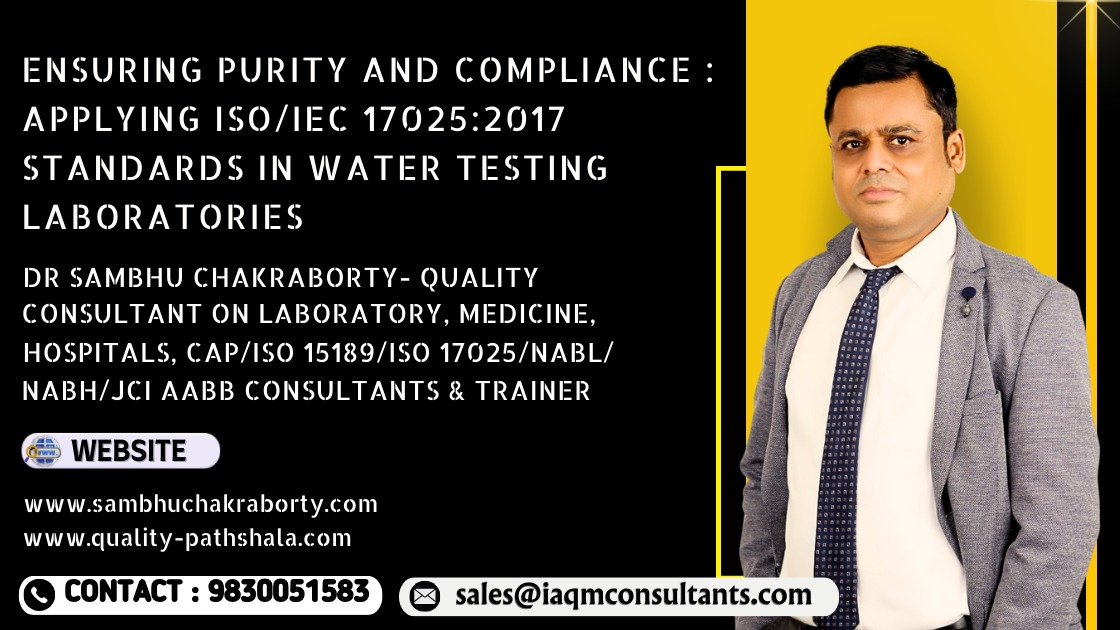Water testing laboratories play a crucial role in ensuring the safety and quality of water for consumption and environmental purposes. Adhering to the ISO/IEC 17025:2017 standard, particularly clause 7.7, is fundamental to maintaining the integrity and validity of their test results. The standard requires laboratories to rigorously monitor their results, detect trends, and apply statistical techniques where appropriate.
Use of Reference Materials or Quality Control Materials: Water testing laboratories often use reference materials to ensure the accuracy of their results. For instance, when measuring chlorine content in drinking water, the lab might use a reference material with a known concentration of chlorine to validate their testing instruments.
Use of Calibrated Instrumentation: Essential testing instruments, such as turbidimeters for assessing water clarity, must be calibrated with traceable standards to guarantee precise results. This is vital for tests that determine the portability of water.
Functional Checks of Equipment: Consistent checks on equipment like conductivity meters are critical. A lab might perform a daily check using a standard conductivity solution to ensure measurements for mineral content or salinity are accurate.
Use of Control Charts: Control charts can be instrumental for processes like water treatment, where parameters such as pH and dissolved oxygen are continuously monitored to detect any significant deviations that could indicate a process control issue.
Replicate Testing: To confirm results, a laboratory might conduct several tests on a single water sample for coliform bacteria. Concordant results from these tests give the lab confidence in the reliability of their process.
Retesting or Recalibration: If water samples from a new source show atypical heavy metal concentrations, retesting or recalibration of analytical instruments like AAS (Atomic Absorption Spectroscopy) may be necessary to verify these findings.
Intralaboratory Comparisons: The lab may perform the same test on one sample in different shifts or by different analysts to ensure that results are consistent, regardless of when or who performs the test.
Proficiency Testing: By participating in external proficiency testing and comparing their results with those from other labs, water testing laboratories can validate their analytical performance, especially for critical contaminants.
Interlaboratory Comparisons: Beyond proficiency testing, labs might also engage in collaborative studies, such as comparing methodologies for detecting lead in water, to ensure they are using best practices and achieving comparable results.
Use of Alternative Instrumentation: A water testing laboratory might use different types of spectrophotometers to measure the concentration of contaminants like nitrates in water samples. By comparing results from these different instruments, which have been calibrated against recognized standards, the laboratory can ensure the robustness of their testing methods.
Intermediate Checks on Measuring Equipment: Regular intermediate checks of pH meters with certified pH buffer solutions are essential for water quality testing. These checks help maintain the accuracy of the pH measurements between periodic calibrations.
Correlation of Results: For a water sample being tested for heavy metals, the laboratory might use both atomic absorption spectroscopy (AAS) and inductively coupled plasma mass spectrometry (ICP-MS). Correlating the results from these two methods can confirm the consistency and validity of the test results.
Review of Reported Results: Every test report issued by the water testing laboratory undergoes a thorough review process. This ensures that the results reported for water quality parameters, such as turbidity or microbial content, are cross-verified with the quality control data and are compliant with the testing standards.
Testing of Blind Samples: The laboratory periodically includes blind samples—samples with known quantities of contaminants, like lead, that are unknown to the testing personnel—within their batch of tests. Successfully identifying and quantifying these contaminants in the blind samples demonstrates the accuracy of the lab’s testing procedures.
When monitoring activities reveal data that strays from pre-defined criteria, immediate corrective action is taken. For example, if a water testing lab consistently detects lower microbial counts compared to proficiency testing results, it might prompt an evaluation of sample handling or incubation conditions.
The practices outlined in ISO/IEC 17025:2017 aim to ensure that water testing laboratories not only deliver dependable and reproducible results but also engage in continual improvement for the accuracy and efficacy of their testing services.
About the Author
Dr. Sambhu Chakraborty is a distinguished consultant in quality accreditation for laboratories and hospitals. With a leadership portfolio that includes directorial roles in two laboratory organizations and a consulting firm, as well as chairman of IOL ( An ILAC stakeholder organization), Dr. Chakraborty is a respected voice in the field. For further engagement or inquiries, Dr. Chakraborty can be contacted through email at director@iaqmconsultants.com and info@sambhuchakraborty.com. Additional resources and contact information are available on his websites,https://www.quality-pathshala.com and https://www.sambhuchakraborty.com or via WhatsApp at +919830051583
